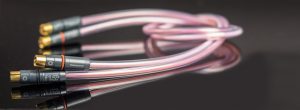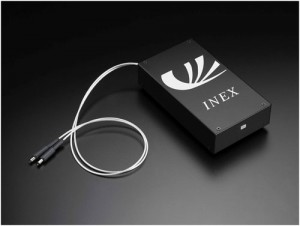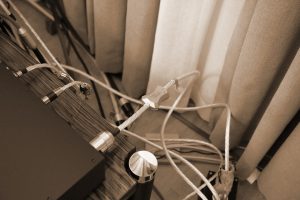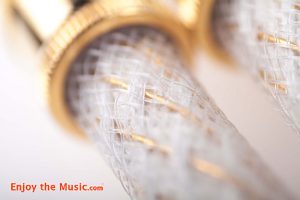
The Jazz Mecca
At one time, you could club hop along 52nd street in New York City and hear the likes of Charlie Parker, Dizzy Gillespie, Charles Mingus, et al., jamming until the wee hours of the morning. More than thirty clubs ranged along the street known as Jazz Alley, at a time when NYC was the jazz mecca of the world.
All gone. Only Birdland survives, today relocated eight blocks south on West 44th street. NYC commemorates this glorious musical past by hosting the Annual Americana Jazz Festival, now in its 40th iteration.
Lynn and I happened to be free that Saturday and looking for something to do. So…why not? We made the trek uptown. Alas, it turned out to be just another of those ubiquitous street fairs with the predictable clan of vendors. The sole nod at a "Jazz Festival" theme was an open-air stage, where the Duke Ellington Jazz Vocal Competition was held. (Later I was happy to come across a couple of jazz LP vendors down the street and snatched some choice originals.)
But the Vocal Competition was of interest. Twenty-two artists at various stages of their careers were given two minutes to sing a tune. Although competing with street noise and amplified over a Bose PA system, each vocalist conveyed a distinct personality and style.
At the time I had some newly arrived interconnects on my mind, and it struck me—this competition could be a useful analogy in that cable review. We'll come back to it a bit later.

The product we're looking at today is an interconnect in TARA Labs' new Evolution series of cables. TARA Labs was keeping a low profile the last few years. Now they're back, ramping up with an advertising campaign. You'll be seeing a lot of audio press reviews coming in the near term. The Evolution series hits many price points: the Air Evolution Interconnects (MSRP $1895) on hand are one level up from the Air Forte, the low rung in the series. At the top you have the Zero Evolution and the off-the-charts Grandmaster Evolution.

I'm listening to Lutoslawski's "Chain 3," volume 1 from the four-CD series of Lutoslawski Orchestral Works recently released by Edward Gardner and the BBC Symphony Orchestra (CHANDOS CHSA 5082, SACD). Somehow, this young conductor has ignited a magical frisson with the second-tier BBC, resulting in a major discovery of this late 20th-century composer. Neglected and sidelined in the USA, Lutoslawski deserves more—in Europe, he is well-esteemed and programmed often. And it sure helps his case that the performance is captured in brilliant CHANDOS engineering. This is an example of why SACD should be adopted as the recording standard.
I inserted a run of balanced Air Evo interconnect between my CH Precision C1 DAC and the Trinity Preamp, and another from the Trinity to the Audionet MAX mono-amps. The rest of the system remained Kubala•Sosna Elation! cables, including the new XPander Power Distributor.

Even on first listening, after a week's burn-in off on the side, the clarity and spaciousness of the soundstage is striking. Massed strings murmur briefly at the opening of the work, quickly followed by tympani and double bass punctuation marks, which come and go fast and tight, like the quick jabs of a lightweight boxer. The orchestra swells into mezzo forte with continuing percussive jabs, then quiets down before moving into a sustained Largo, scored mostly for low strings, which continue to murmur underneath the chattering woodwinds.
The full orchestra ramps up again at about four minutes and the sound takes off, spreading laterally across the span between my YG Anat speakers. Soundstage width is excellent; depth is fine, if not quite as good, but no reason to complain.
The Air Evo are neither bright nor dark: when they went in I did not have to re-balance or make any adjustments. Frequency response is smooth and evenly allocated, with good extension on both ends. I found the treble slightly more pointed and focused than the bass and midrange, which makes this band a little more forward. This has a two-pronged effect: On the one hand, it promotes clarity and articulation; on the other, I would not characterize them as laid-back.
Air Evo transients are sharp edged and fast, as fast as any cable I've come across. Related to that, the tail of notes, while not exactly truncated, is on the short side. This handling makes for very quick coming and going of events.
The Timbral Envelope
I must say, strings are impressively rendered. They don't exhibit any abrasiveness. (I always find TARA's Ceralex, described below, to be useful here.) While not lavish, timbre and tone are convincing and the gestalt of the instruments is nicely conveyed. The soundstage is populated with tall and a bit skinny images, their borders sharply defined, so imaging is discrete with little overlapping or blending. Resolution is sufficiently high so that a solo instrument can be readily distinguished from a duet. Likewise, the volume occupied by a mass of instruments is conveyed.
Soundstage
This amalgam of Air Evo qualities makes reading the orchestra an easy call. There is no confusion, no vagueness; each instrument sounds like itself and is located where you expect it to be. The Air Evo doesn't seem to add anything. It's a very straight-ahead type of sound, totally free of mechanical artifacts and noise on the one hand, and musical embellishments on the other. The cables clearly conform to TARA's enviable reputation for neutral voicing.
Cable Categories
Now it's time to recall the Duke Ellington Jazz Vocal Competition. The twenty-two artists spanned the gamut of talent with most in the average category, a few dreadfuls, and two or three outstandings. This was over a PA system at an open air street fair—a truly low-res situation. Of course, in an actual concert hall, there would be a ton of additional info. Yet, it was easy to discern differences in vocal quality.
That's what made it entertaining and I imagined the judges were going to be in for a tough time. And that's when the analogy to audio cables came up. Cables come in a variety of price and performance points. What do you get at the different levels?
A while ago, my colleague Bob Levy used to rank cables into price categories as follows:
- $4000 and up, per meter: Top Tier
- $2000 to $4000: Mid Level
- up to $2000: Low End, with several sub-tiers
This was back in 2010. Given inflation plus the general tilt towards more expensive products, the rankings need to move as well to be realistic in the here and now. The Air Evo, at $1895/meter, clearly fall into the Low End of today's market. Shocking, isn't it?
What's Expected
What are the expectations for a $1895/m product? I asked around among the cognoscenti and came up with a consensus opinion: a cable at this price point should have good all-around performance and not evidence serious fall-off anywhere. It should not have any issues.
Yup—you could certainly say that about the Air Evo. I mentally checked off every item on the Audiophile Report Card and there is no area of slackness that I need to call to your attention. Well done.
What It Doesn't Do
Actually, it is a lot better than that. It wasn't until I compared the Air Evo to the Top Tier cables that omissions became apparent. Against my reference K•S Elation! (MSRP $6000/m) and other Top Tier cables, the differences lay in the realm of escalating refinements.
For example, the Air Evo does the imaging thing, placing instruments in space at discrete points and layering depth. However, compared to the Top Tier, instruments are less fleshed out and have less individual depth, less 3D rounding. They appear a bit flat. Timbres, as noted above are good, but the full complexity and beauty of the higher-priced spread is not there. Musical flow, defined as what happens when going from one note to the next (a particular strength of the K•S Elation!) is not the same. And the quality of air and ambience in different recording venues is left unresolved.
What the Top Tier offers is the icing on the cake, heard in the refinements that bring you closer to the performance. It is not a huge difference, but it is an important one and the cost is huge.

On a side note, another observation expressed by the cognoscenti is that as you move up within a cable brand, the house sound should remain a constant. For example, comparing TARA's The 0.3 with HFX (MSRP $8,900) to the Air Evo, there is a percentage of "better" in every category: still, the voicing is recognizably by the same designer. There should not be a radical change from one cable to the next within the same brand.
Cable Construction
The Air Evo interconnects have a newly designed air tube construction with Teflon and Aero PE filament, which ensure a high percentage of overall air dielectric. TARA Labs claims an amazingly low 4 pF per foot capacitance for the Air Evo interconnects, which provides "…more than twice the high frequency bandwidth of the famous Air 1 Interconnect."
Conductors
Each leg of the Air Evo interconnect uses a separate positive and negative run of conductor material made from SA-OF8N copper utilizing Rectangular Solid Core Gen 2 geometry. (The Super Annealed™, Oxygen-Free Eight Nines process creates one long, unbroken single crystal, or mono-crystal, structure.)
Cable Grounding
TARA Labs Technical Design Team has always been a big proponent of floating the ground on their cables. That's why they have an elaborate system of pigtails, mini bananas, RCA plugs and sometimes outboard Ground Stations.

Like the upper-end TARA cables, the Air Evo interconnects have pigtails sprouting on both ends. The source side of the cable has mini-bananas that plug into the outboard EVO Floating Ground Station (FGS). The EVO FGS, in turn, is connected via mini-banana pins to ground somewhere on the component's chassis. In this way, the EVO FGS provides an independent ground path.
On the load side, the Air Evo has mini-bananas that lock together. Thus, the ground wire is lifted on both ends—a true floating ground.

EVO Floating Ground Station
Ceralex Compound
The EVO Floating Ground Station employs passive noise reduction technology in the form of a patented compound called Ceralex. Whatever EMI/RFI is riding along the ground wire is dumped into the EVO FGS and absorbed by the Ceralex inside.
You hear this as the removal of noise and smearing. The Floating Ground Station doesn't change tone or timbre but makes everything clear and sharp. Disconnect the FGS and you lose focus.
Conclusion
The TARA Labs Air Evolution Interconnect with EVO Floating Ground Station is advertised as "completely neutral and absolutely revealing with high frequency and airy detail that is not found in comparable audio cables." It is certainly neutral, revealing, and loaded with detail.
At $1895 for a meter length, the Air Evo fall into what must be considered the Low End price point for audio cables. How they stack up against the competition required some investigation. I queried the audio cognoscenti for definitions and expectations at different price points.
They clearly exceeded the base-line for a Low End cable, in most respects falling in line with expectations for a Mid Level product. Shortfalls only appeared when I shifted gaze to Top Tier cables. What the Air Evolution doesn't give you lies in the realm of refinements, the tasty garnishes that are like icing on the cake and only available from the best-of-breed.
The bottom line is TARA Labs new Air Evolution cables are out-sized performers and offer a big bang for the buck. Highly recommended without reservation for those shopping at this price point. Marshall Nack
Air Evolution Interconnect
Retail: $1295 / 1m
Air Evolution Interconnect with EVO Floating Ground Station
Retail: $1895 / 1m, Additional meter $250
TARA Labs
550 Clover Lane, Ashland OR 97520
Phone: (541) 488-6465













































